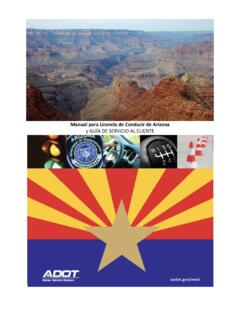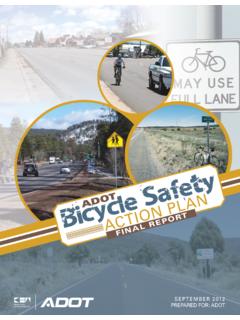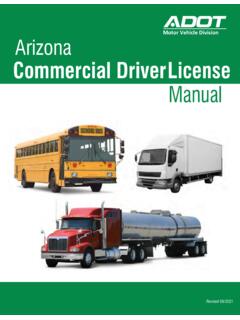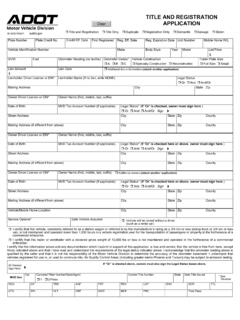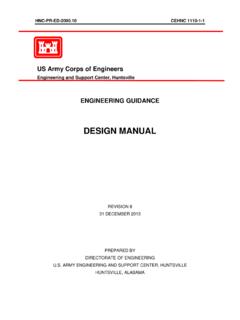Transcription of Pavement Design Manual - ADOT
1 ARIZONA DEPARTMENT OF TRANSPORTATION Pavement Design Manual September 29, 2017 ROADWAY engineering GROUP Pavement Design SECTION Pavement Design Manual Published by: Arizona Department of Transportation Roadway engineering Group Pavement Design Section 205 South 17th Avenue Phoenix, Arizona 85007 (602) 712-7360 Page i TABLE OF CONTENTS PREFACE .. iv INTRODUCTION .. 1 Project Determination .. 1 Data Collection .. 1 Field Survey .. 4 Geotechnical Information .. 4 Traffic Analysis .. 5 Preliminary Plans .. 5 Subgrade Support Considerations New Construction, Reconstruction and Widening .. 6 Subgrade Tabulations .. 6 8 Other Considerations .. 9 Pavement Coring.
2 9 NEW Pavement Design .. 11 Flexible Pavement Design .. 11 18-kip Equivalent Single Axle Loads (W18) .. 12 Standard Normal Deviate (ZR) .. 12 Combined Standard Error (SO) .. 12 Change in Present Serviceability Index ( PSI) .. 13 Resilient Modulus of Subgrade (MR) .. 13 Correlated R-value (RC ).. 13 Mean R-Value (Rmean) .. 16 Construction Control R-Value (Control RC ) .. 23 Structural Number (SN ) .. 24 Layer Coefficient (ai ) .. 24 Drainage Coefficient (mi ) .. 29 Asphalt Grade Selection .. 29 Rigid Pavement Design .. 30 Minimum Pavement Design 35 Selection of Optimal Design .. 37 Pavement REHABILITATION .. 38 Flexible Pavement Rehabilitation .. 38 SODA Method.
3 38 Other SODA Considerations .. 40 Overlays Other Than SODA .. 41 Rehabilitation Design Validation .. 42 Page ii Rigid Pavement Rehabilitation .. 42 WIDENING .. 44 Design DOCUMENTATION AND PRESENTATION .. 45 Pavement Design Summary .. 45 Outline of Pavement Design Summary .. 45 Materials Design Report .. 47 Outline of Materials Design Report .. 48 Preliminary Pavement Structure Cost Estimate .. 50 Design REVIEW AND DISTRIBUTION .. 51 Review, Approval and Distribution of Initial Materials Design Package .. 51 Review, Approval and Distribution of Final Materials Design Package .. 51 ADDITIONAL RESPONSIBILITIES .. 52 Reviewing Contract Documents .. 52 Construction Support.
4 52 APPENDIX A TRAFFIC DATA AND ANALYSIS (CONVERTING MIXED TRAFFIC TO EQUIVALENT SINGLE AXLE LOADS FOR Pavement Design ) .. A-1 APPENDIX B Pavement Design FOR FROST ACTION .. B-1 Page iii LIST OF TABLES Table 1-1 Data Requirements for Different Types of Construction Projects .. 2 Table 2-1 Reliability and ZR Values .. 13 Table 2-2 Serviceability Index .. 13 Table 2-3 Correlated R-value at 300psi. Exudation Pressure (RC) .. 15 Table 2-4 Seasonal Variation Factors (SVF ) .. 20 Table 2-5 Critical t Values .. 23 Table 2-6 Structural Coefficients for Surfacing and Base Materials .. 24 Table 2-7 Drainage Coefficients (mi) .. 29 Table 2-8 Load Transfer Coefficients (J Factor) for Rigid Pavement with Tied Concrete Shoulders.
5 31 Table 2-9 Loss of Support .. 32 Table 2-10 Minimum Structural Numbers and Composite Thicknesses (Flexible Pavements) .. 36 Table 3-1 Minimum Rehabilitation Treatment for Flexible 41 Table 3-2 Leveling Requirements on Overlay Projects .. 42 Table 3-3 Concrete Non-Structural Rehabilitation .. 43 Table A-1 Truck Traffic Classifications .. A-4 Table A-2 Lane Distribution Factors (DL) .. A-5 Table A-3 Design ESAL s for Ramps, Crossroads, Frontage Roads, Rest Areas and Parks .. A-6 Table A-4 Truck Load Factor Clusters .. A-8 Table A-5 Truck Load Factors for Flexible Pavements .. A-8 Table A-6 Truck Load Factors for Rigid Pavements .. A-8 LIST OF FIGURES Figure 1-1 Typical and Structural Sections.
6 3 Figure 2-1 Seasonal Variation Factors .. 19 Figure 2-2 R-value to Modulus Conversion Chart .. 22 Figure 2-3 Structural Layer Coefficient of Asphalt Bound Materials .. 26 Figure 2-4 Structural Layer Coefficient of Chemically Stabilized Base and Subgrade .. 27 Figure 2-5 Structural Layer Coefficient of Unbound Granular Base .. 28 Figure 2-6 Correction of Modulus of Subgrade Reaction for Potential Loss of Base/Subbase Support .. 33 Figure 2-7 Composite Modulus of Subgrade Reaction (koo) .. 34 Figure A-1 FHWA Vehicle Classifications .. A-3 Figure A-2 Typical Functional Classification Map .. A-7 Figure A-3 Design ESAL Calculation Worksheet .. A-10 Figure B-1 Freezing Index Map .. B-3 Pavement Design Manual September 29, 2017 Page iv PREFACE The American Association of State Highway Officials (AASHO) issued its interim guides for the Design of flexible and rigid pavements in 1961 and 1962 respectively, following the 1958 1960 Road Test.
7 In 1986, the American Association of State Highway and Transportation Officials (AASHTO) published a comprehensive revision under the title 1986 AASHTO Guide for the Design of Pavement Structures. Then, in 1993, the guide was updated to incorporate major changes in its overlay Design procedure and related appendices. The Arizona Department of Transportation (ADOT) has used the AASHO/AASHTO guides as its basis for Design since it was first issued in 1961. Arizona s present Pavement Design guide was developed by the Materials Section in 1989 with revisions issued in 1991 and 1992. A revision was not issued to formally adopt the 1993 version of AASHTO Guide for the Design of Pavement Structures because ADOT had developed and adopted its own overlay Design procedure in 1984 termed Structural Overlay Design for Arizona (SODA).
8 The purpose of this Manual revision is to present guidance on how ADOT currently uses the 1993 AASHTO Guide for the Design of Pavement Structures to Design new pavements, and SODA to Design asphalt overlays. Significant changes since the last Manual update include: modifying the method of calculating the Design R-value for highly variable subgrade soils, revising the combined standard error ( ) for rigid pavements, updating the format and presentation of the Materials Design Package, updating the SODA equation to reflect roughness measurements based on International Roughness Index (IRI) rather than Mays Meter values, and a new procedure for calculating Design equivalent single axle loads (ESAL s).
9 It should be noted that the structure and format of ADOT s Pavement Design guidance has changed since it was last revised in 1992. Previously, guidance for Pavement Design activities was included in the Materials Preliminary engineering and Design Manual . However, reorganizational changes have resulted in a decision to issue this guidance as a stand-alone document under the title of ADOT Pavement Design Manual . It should also be noted that in 2008, AASHTO released the Mechanistic-Empirical Pavement Design Guide: A Manual of Practice (MEPDG). The accompanying software, AASHTOWare Pavement ME Design , was released in 2011. In 2010, ADOT contracted with Applied Research Associates, Inc.
10 (ARA) to perform a local calibration for the MEPDG procedure. Since completing the local calibration in 2012, ADOT has been performing parallel designs using both the 1993 AASHTO Guide for the Design of Pavement Structures (or SODA for overlay Design ) and the MEPDG. MEPDG designs are currently being performed in accordance with a draft Design guide titled Arizona DOT User Guide for AASHTO DARWin-ME Pavement Design Guide. Results from both procedures are typically considered when developing a final Design solution for a project. Pavement Design Manual September 29, 2017 Page 1 INTRODUCTION This Manual provides the procedures used by the Arizona Department of Transportation for the Design of new pavements and rehabilitation of existing pavements; both rigid and flexible.
